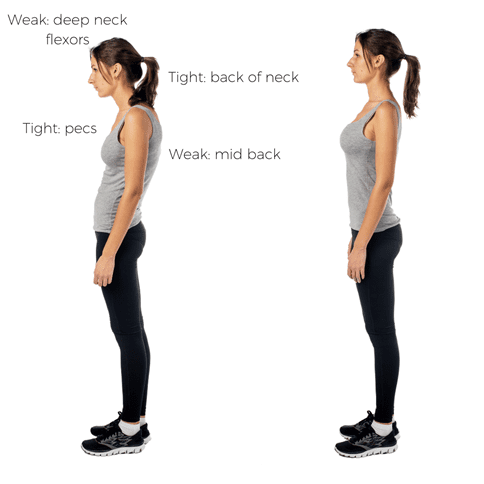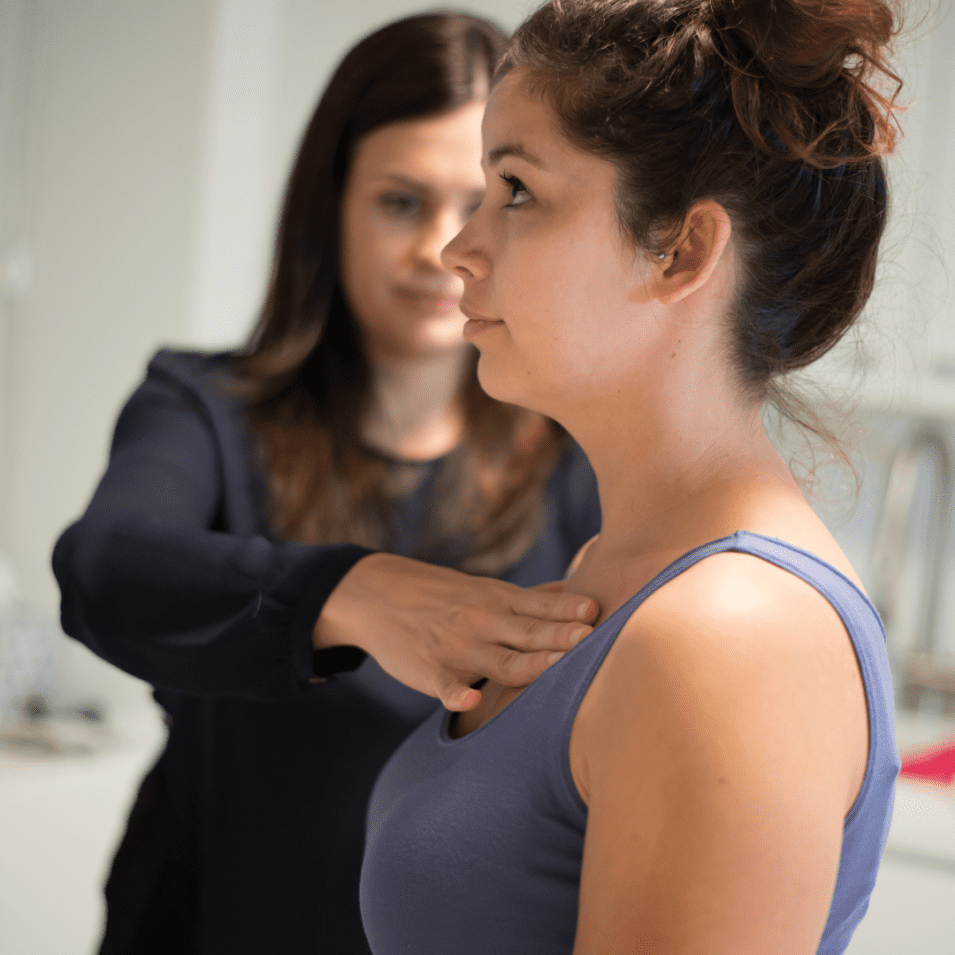How Improved Posture Leads to Reduced Shoulder Pain.
What is the most common faulty upper body posture?
We all recognize it, and probably can relate to some degree. It’s that slumped sitting, rounded shoulders, and forward head position that’s all too easy to get into. This can happen while sitting at a desk, looking at your computer, or even standing looking down at your phone.
This is commonly described as Upper Crossed Syndrome as seen below:

The important part to note in this posture (image on the left) is the lengthening and weakening of the muscles in the mid back. This includes muscles of the posterior rotator cuff (on the back of the shoulder blade) as well as muscles that border along the inside of the shoulder blade.
When these muscles become weak, the shoulder blade and shoulder itself are no longer properly supported. This can lead to several issues including shoulder impingement and rotator cuff tendon strains or tears.
How physical therapy improves posture + reduces shoulder pain:
In a physical therapy initial evaluation, your therapist will individually examine your posture as well as the mechanical restrictions and strength deficits associated with your posture. With that information, your therapist will determine which areas need to be addressed. This can be done with manual treatment – this often includes dry needling. But also can determine which areas need focused motor control and strength rehab exercises to better support your system.
You will also get an assessment of your shoulder itself, including strength and range of motion, to determine your current state of function and baseline measurements.
All of these tests and measures are analyzed to determine how your posture and shoulder may be influencing each other and what your treatment will include.
The Bottom Line
The shoulder complex is a series of muscles, tendons, ligaments, bones and joints that work together to successfully lift your arm and allow you to lift, carry, throw, etc. All of these tissues need to work in harmony together to allow these motions to occur. When there’s a change or break in the system, i.e. chronic poor posture changing the state of the muscles that support your shoulder blade, your body may adapt for a while but then tissue damage sets in and that’s when you experience dysfunction and/or pain.

Common exercises to focus on for improved posture & increased shoulder support:
(*the is not medical advice, always consult with your provider before initiating any exercise)
So what can you do about this? The first step is awareness! Recognizing posture may be a factor in your shoulder pain will be helpful in taking steps toward changing it. Your physical therapist will be able to tell you the specifics of your shoulder diagnosis and postural deficits. The most common weaknesses found with upper crossed syndrome are with shoulder retraction/protraction (moving shoulder blades forward and back on the ribcage) as well as external rotation of the shoulder.
Exercise for shoulder retraction (drawing shoulder blades closer together):
Prone I, W, and Ts are helpful either laying on your stomach or standing at the wall
For this exercise, you will lay face down with your arms by your side and your forehead supported by a towel roll. You will then lift your arms and draw your shoulder blades together to activate the muscles in your mid back. Hold for 3 seconds and then relax, repeat 10 reps.
Exercises for shoulder external rotation:
- Laying on your side and doing external rotation with your elbow bent to 90 degrees with 2-3#
- Standing with a band with elbows bent to 90 degrees locked at your sides and externally rotating your arms out
- Laying on your stomach with your arm off the side of the table, with your shoulder at 90 degrees, prone row and then lift hand toward ceiling to externally rotate your arm, slowly lower back down and repeat.
About the author:

Dr. Samantha Dove is originally from San Antonio, Texas and has recently moved to Cincinnati from Atlanta, GA with her husband Sam and their dog Koda.
She was a springboard and platform diver for the University of Texas at Austin and has been a Doctor of Physical Therapy for over 5 years. Dr. Dove treats all orthopedic conditions with special interest in the spine, chronic pain, vestibular, and TMJ/TMD populations. She has her Manual Therapy Certification through the University of St. Augustine (USA) and has extensive dry needling training with KinetaCore.
Dr. Dove highly values continuing education in a variety of physical therapy topics but has taken special interest in the CranioFacial courses through USA to advance her TMD treatment skills. Health and wellness are a natural interest of hers in her personal life including participating in activities such as yoga, running, gardening, reading, cooking, family walks at Eden Park and all things self care! She is very excited to explore Cincinnati and to be joining the team at Anchor Wellness Center!


